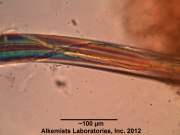Rosa canina (fruit)
(Nomenclature updated) |
|||
| Line 1: | Line 1: | ||
| − | = | + | =Nomenclature= |
| + | |||
| + | {{nomenclature | binomial=Rosa canina | ||
| + | |authority=L. | ||
| + | |family=Rosaceae | ||
| + | |scn=dog rose | ||
| + | |syn= | ||
| + | |ayurvedic= | ||
| + | |pinyin= | ||
| + | |aka=dog brier; brier rose | ||
| + | |notes=This species of Rosa is a primary source of rose hips. The use of this common name for the plant's fruit is well established and is an acceptable and even preferable standard common name. }} | ||
| + | |||
=Macroscopic Entries= | =Macroscopic Entries= | ||
=Microscopic Entries= | =Microscopic Entries= | ||
Revision as of 21:33, 14 March 2014
Contents |
Nomenclature
Rosa canina L. Rosaceae
Standardized common name (English): dog rose
Macroscopic Entries
Microscopic Entries
|
HPTLC Entries
|
Rosehips (fruit) (Rosa canina) Lane Assignments Lanes, from left to right (Track, Volume, Sample):
Reference materials used here have been authenticated by macroscopic, microscopic &/or TLC studies according to the reference source cited below held at Alkemists Laboratories, Costa Mesa, CA. Stationary Phase Silica gel 60, F254, 10 x 10 cm HPTLC plates Mobile Phase toluene: acetone: HCOOH [6/3/1] Sample Preparation Method 0.3g+3mL 70% grain EtOH sonicate/heat @~50° C ~ 1/2 hr Detection Method Vanillin/H2SO4 Reagent -> 110° C 5 min -> visible light Reference see Adapted from European Pharmacopoeia 5.0 2005
|
Other Points of Interest
Cite error: <ref> tags exist, but no <references/> tag was found


